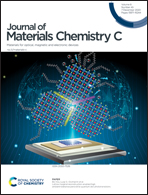Conjugation-extended viologens with thiophene derivative bridges: near-infrared electrochromism, electrofluorochromism, and smart window applications
Abstract
Two types of thiophene derivatives, i.e., thiophene (T) and 3,4-ethylenedioxylthiophene (ET) with a single thiophene ring, and thieno[3,2-b]thiophene (TT) and 2,2′-bithiophene (BT) with double thiophene rings, have been inserted between the two pyridinium units of an octyl viologen (V). The effective conjugation lengths of the resulting thienoviologens TV, ETV, TTV, and BTV have been successfully extended. Unlike a traditional alkyl viologen, which always serves as a fluorescence quencher, all four thienoviologens exhibit intense photoluminescence (PL). The bathochromic shifts in both absorption and PL spectra are more pronounced in TTV and BTV with double thiophene rings as compared with TV and ETV with a single thiophene bridge. Moreover, upon applying a negative potential, all four thienoviologens display significant changes in both absorption and PL spectra, indicating their electrochromic (EC) and electrofluorochromic (EFC) properties. Additionally, the EC response can be found not only in the visible but also in the near-infrared (NIR) region. Although TTV and BTV with longer conjugated bridges exhibit more extended effective conjugation lengths and higher PL quantum yields, the EC and EFC devices based on TV and ETV gels display better performance than that for TTV and BTV owing to the faster charge and mass transport for smaller molecules. Consequently, a better comprehensive property is achieved by the ETV-based gel, which demonstrates fast coloration (1.9 s), high color contrast (87%), and high coloration efficiency (521 cm2 C−1) in the EC device with high fluorescence contrast ratio (Ion/Ioff = 221) in the EFC device. Furthermore, two smart windows have been fabricated to utilize their different driving potentials. Upon increasing the potential, the “window flower” in the first device blossoms out with gradually changing petal colors, while the other dual-functional smart window can be adjusted between flower decoration and light blocking functions.



 Please wait while we load your content...
Please wait while we load your content...